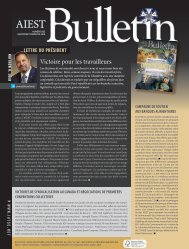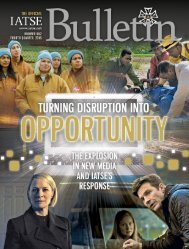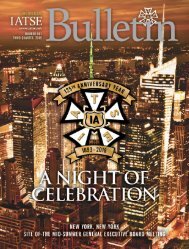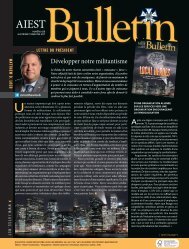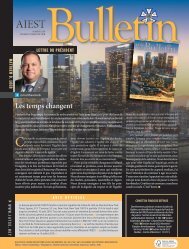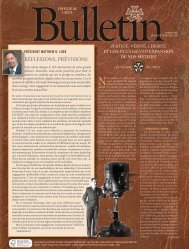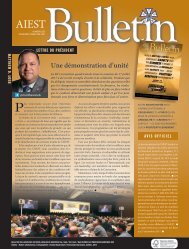IATSE-2nd2018_web
You also want an ePaper? Increase the reach of your titles
YUMPU automatically turns print PDFs into web optimized ePapers that Google loves.
In addition, movie chains owned by the major studios made<br />
it even harder for independent theater owners to compete. In<br />
1948, the Supreme Court ruled (in U.S. v. Paramount Pictures,<br />
Inc.) that the studios had to divest themselves of their theaters.<br />
That effectively eliminated the guaranteed out let for the studios’<br />
product, no matter how good or bad that product was. These<br />
rulings effectively eliminated the studio system.<br />
At the same time, more and more Americans were buying<br />
television sets and staying away from movie theaters. Television<br />
promised work for <strong>IATSE</strong> members (after jurisdictional and<br />
technical problems were resolved), but initially the new medium<br />
had a very negative impact on studio workers.<br />
The movie industry went into its own kind of great<br />
depression. Thousands of studio workers were laid off. Sound<br />
stages and outdoor sets were left empty. The larger studios,<br />
which had acres of sets and hundreds of players under contract,<br />
were hit the hardest.<br />
Smaller studios like Columbia managed to survive. And in<br />
1951, Columbia had the wisdom to establish its own television<br />
division, Screen Gems. Ultimately, thousands of <strong>IATSE</strong> members<br />
would work for Screen Gems, making the transition from movies<br />
to TV.<br />
Sadly, one by one, the great movie palaces began to close<br />
down. The shift of the population to the suburbs and away<br />
from the city centers where these palaces were located hastened<br />
the decline of the movie industry and cost thousands of IA<br />
projectionists their jobs.<br />
INNOVATION SAVES THE DAY<br />
Alliance members’ skills and our ability to adapt to rapid<br />
change were tested during the 1950s and 1960s, as the movie<br />
industry attempted to find ways to win back consumers who now<br />
sought their entertainment through television, sports events and<br />
outdoor activities.<br />
One of the first innovations <strong>IATSE</strong> members had to contend<br />
with was 3-D, a three-dimensional, stereoscopic novelty that<br />
was produced by shooting the same scene through two separate<br />
lenses set apart but contained in a single camera. Alliance<br />
camerapeople and projectionists alike enthusiastically did their<br />
part to make the new process successful.<br />
Cinerama was another novelty that came on the scene at<br />
about the same time. This process, developed around 1953, held<br />
great promise since it did not require the uncomfortable and<br />
awkward glasses of 3-D. The Cinerama experience brought the<br />
audience into the action, as opposed to 3-D, which brought the<br />
action to the audience. It created the sensation that the body was<br />
in motion. It was, in its day, like a wild ride at Disneyland.<br />
Again, <strong>IATSE</strong> members eagerly embraced Cinerama despite<br />
its shortcomings, one of which was its complex projection process,<br />
which meant only a few theaters in major cities were equipped for<br />
it. It was marketed much like the road company of a Broadway hit,<br />
with reserved seats, scheduled performances and high ticket prices.<br />
Cinerama ran into trouble when producers tried to use it as a<br />
legitimate process for feature production. Films such as How the<br />
West Was Won and It’s a Mad Mad Mad Mad World were simply<br />
overwhelmed by the grand scope of Cinerama.<br />
And there was increasing competition from another new<br />
process — Cinemascope, which was touted as offering 3-D effects<br />
without expensive lenses and costly alterations to projection<br />
equipment. Theaters would need special screens developed by<br />
Cinemascope’s creator, 20th Century-Fox. The screens were<br />
sixty-four feet wide by twenty-five feet high and curved to a<br />
depth of five feet, giving the feeling of being surrounded by the<br />
action. Accompanied by stereophonic sound, Cinemascope, it<br />
was claimed, would engulf the viewer.<br />
These new processes required some adjustment by directors<br />
and <strong>IATSE</strong> camerapeople. The wide frame now had to be filled<br />
in with sets, props, and action. Actress Lauren Bacall said that<br />
55







